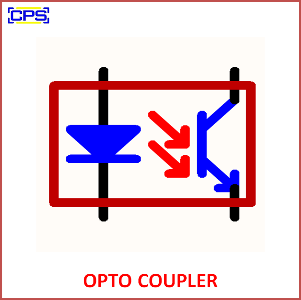An Opto-coupler, also known as an Opto-isolator, is an electronic component that transmits electrical signals between two isolated circuits by using light. It typically consists of an LED (light-emitting diode) on the input side and a photodetector (like a phototransistor, photodiode, or photometric) on the output side. The two sides are electrically isolated but optically coupled, allowing signals to pass without direct electrical connection.

Key Features of an Opto-coupler:
- Electrical Isolation:
- Provides galvanic isolation between the input and output, preventing high voltages or noise from affecting sensitive parts of the circuit.
- Signal Transmission:
- Uses light to transmit signals across the isolation barrier, often in the form of infrared light emitted by the LED.
- Types of Output Devices:
- The output photodetector can be a phototransistor, photodiode, photoSCR, or other light-sensitive elements.
Working Principle:
- When an electrical signal is applied to the LED side (input), the LED emits light. This light is detected by the photodetector on the output side, which generates a corresponding electrical signal. The two circuits are electrically isolated, which enhances safety and noise immunity.
Applications:
- Signal Isolation:
- Used in circuits where isolation between high-voltage and low-voltage components is required, such as in power supplies, microcontrollers, and relays.
- Noise Reduction:
- Helps reduce electromagnetic interference (EMI) and noise by isolating different parts of a circuit.
- Data Communication:
- Transmits data between circuits operating at different voltage levels or in environments with electrical noise.
- Switching:
- In control systems and logic circuits, opto-couplers are used to trigger switches or relays while maintaining isolation.
Advantages:
- Isolation: Prevents high voltages from affecting sensitive electronics.
- Noise Immunity: Protects circuits from noise and voltage spikes.
- Safety: Provides safety in high-voltage environments, such as industrial or medical equipment.
Disadvantages:
- Speed Limitations: Opto-couplers may have slower response times compared to direct electrical connections, limiting their use in high-speed applications.
- Temperature Sensitivity: The performance can degrade with temperature fluctuations.
- Limited Current Handling: They are generally limited in the amount of current they can handle compared to mechanical relays.
In summary, an Opto-coupler is a key component for providing electrical isolation and protecting circuits while allowing signal transmission via light, commonly used in power electronics, data communication, and safety-critical systems.
